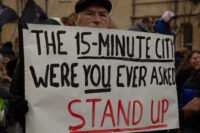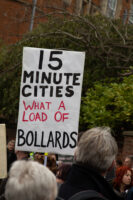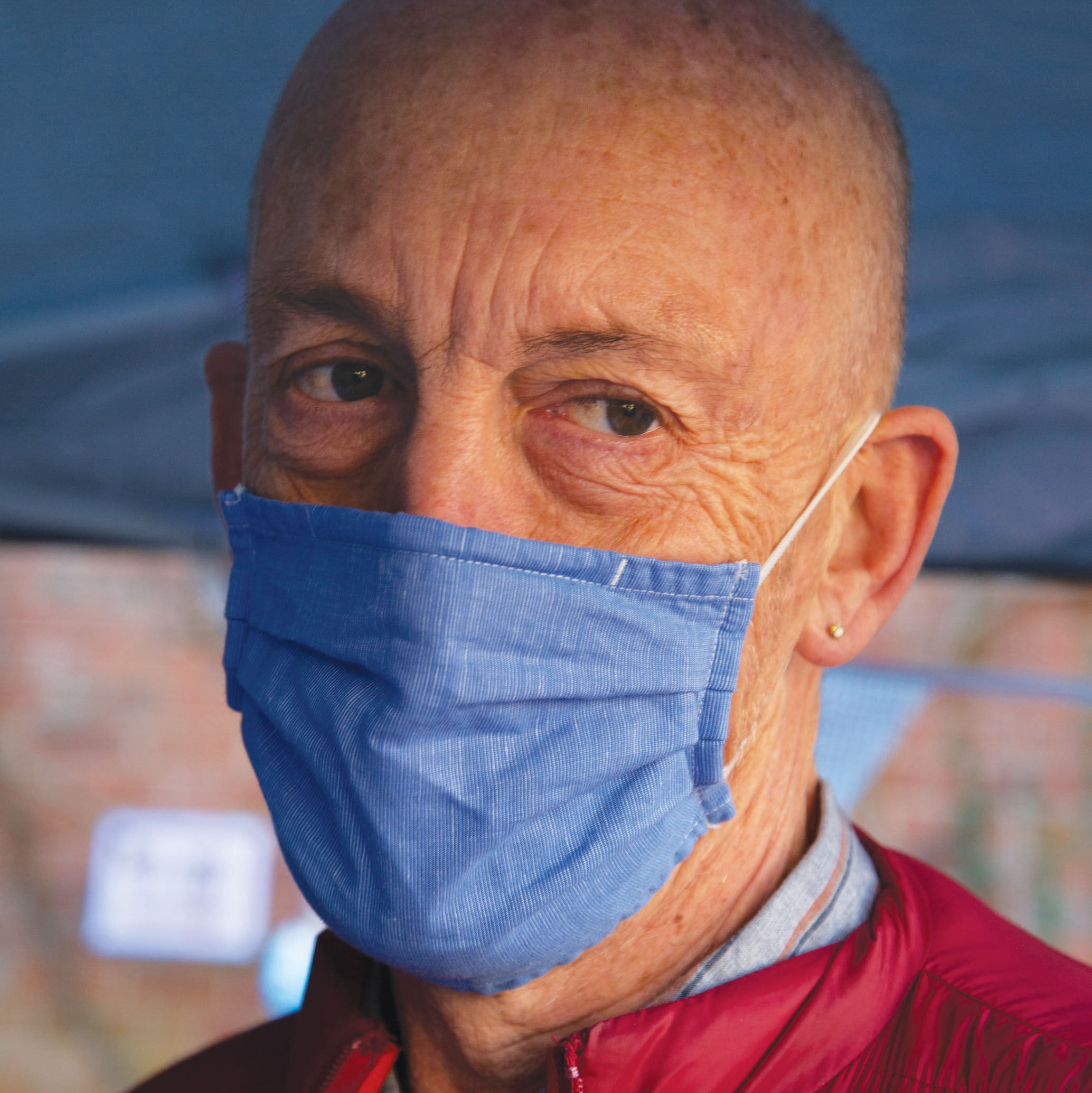15 minute neighbourhoods and the rise of climate denialism
It is a strange feeling being at the centre of a national and international ‘culture war’ storm. And even stranger that that storm is about a planning theory. But that has been how it has been for the past 10 months living on a fairly unprepossessing street off a somewhat down-at-heel main road, Cowley Road, in Oxford. The cause of this sudden notoriety?  A long overdue attempt by the local transport authority, Oxfordshire county council, to engage with the need to address the climate crisis and the specific issue of transport emissions as part of a national policy to reach ‘net zero’ carbon emissions by 2050. That commitment has local interim targets including a 25% reduction in transport emissions by 2030. Locally transport now accounts for 40% of emissions, so the county council’s plan is to reach that target through a series of measures including establishing Low Traffic Neighbourhoods (LTN’s), a city centre ‘zero emissions zone’, greater focus on an efficient and frequent bus service, the introduction of electric buses, and greater commitment to ensuring their timeliness with the introduction of ‘bus gates’, which allow for their freer movement by restricting the amount of vehicle traffic especially at peak times.
A long overdue attempt by the local transport authority, Oxfordshire county council, to engage with the need to address the climate crisis and the specific issue of transport emissions as part of a national policy to reach ‘net zero’ carbon emissions by 2050. That commitment has local interim targets including a 25% reduction in transport emissions by 2030. Locally transport now accounts for 40% of emissions, so the county council’s plan is to reach that target through a series of measures including establishing Low Traffic Neighbourhoods (LTN’s), a city centre ‘zero emissions zone’, greater focus on an efficient and frequent bus service, the introduction of electric buses, and greater commitment to ensuring their timeliness with the introduction of ‘bus gates’, which allow for their freer movement by restricting the amount of vehicle traffic especially at peak times.
Oxford is a notoriously congested city, something that has much to do with its history. A famous university town with a medieval street pattern wholly unsuited to the demands of the motor vehicle – a problem acknowledged since the 1930s. Oxford is well used to attempts at addressing these issues. Decades were spent resisting (ultimately successfully) proposals for an inner city ‘relief road’ across Christ Church Meadows immediately after WW11, the ‘Park and Ride’ system of City-edge parking to bring commuters and shoppers (but not their cars) into town has been established for 50 years, and a small number of ‘bus gates’, for instance on the High Street, have been a feature of the urban landscape for decades. So the new proposals build upon existing policies and schemes that are well established. But the speed of the process – in part influenced by the opportunity presented by the lockdowns and traffic reductions during the Covid pandemic of 2020-22, has caused surprise and in some quarters anger and resistance. Large areas of Cowley had LTN’s installed in 2021 and a further programme in east Oxford, including the street that I live had them installed in 2022. All of them are experimental at first – the Cowley area ones were confirmed after a year, and the east Oxford ones are still ‘work in progress’.
However the barriers do cut across traditional traffic routes though residential areas. Surveys on my own street showed 6,000 vehicles a day passing my front door before the introduction of the LTN. By blocking off all the streets coming off Cowley Road the intention has been to: make the residential streets more pleasant places to live, less noise, less air pollution, easier for cyclists and pedestrians to navigate, a means of encouraging people to drive less and walk short distances to local facilities – the concept of ‘the 15 minute city’, and reduce overall vehicle use, so reducing emissions, with ‘bus gates’ giving priority to bus users to encourage people using more distant facilities or unable to cycle, to use reliable and frequent public transport rather than their own vehicles. For those needing to use a vehicle, a system of exemptions – 100 passes per year to travel through the ‘bus gates’ are to be issued with other journeys to be undertaken by using main arterial roads and the ring road to access different parts of the city. This has proved highly controversial, because objectors have argued that this simply moves air pollution from residential streets to other places, and exacerbates it by forcing people to take longer routes to their destination and often to get caught up in congested traffic in the process. Supporters argue that the ring road isn’t a residential street – true, but many arterial roads are, and that ‘traffic evaporation’ ie people turning to other means of getting around the city other than in their own vehicle, will in time bear fruit.
Meantime on the ground reactions have been swift, violent and in many respects alarming. Many of the LTN’s have been repeatedly vandalized with bollards stolen, sawn through or burnt, planters covered in graffiti and frequent confrontations between vehicle drivers and local residents who have styled themselves ‘human bollards’ with significant numbers being assaulted and some ending up in hospital. A number of drivers have been charged with assault but the Police won’t intervene, so it has required residents recording incidents on phones to ensure charges and convictions. While it is probably fair to say that over 90% of vehicle drivers respect the LTN barriers, a small number of mainly male car drivers in large vehicles feel entitled to dominate residential areas and intimidate local communities.
A number of drivers have been charged with assault but the Police won’t intervene, so it has required residents recording incidents on phones to ensure charges and convictions. While it is probably fair to say that over 90% of vehicle drivers respect the LTN barriers, a small number of mainly male car drivers in large vehicles feel entitled to dominate residential areas and intimidate local communities.
There have been heated arguments about the impact on local businesses too. Many Cowley Road traders believe that LTNs have seriously damaged their businesses although factors both national and local will have had a much greater impact (1). This has led to the politicization of the anti-LTN campaign with candidates hostile to their introduction standing for election to the City council (not the transport authority) across east Oxford in May 2022. None were elected, but typically picked up about 20% of the vote. City wide opinion polls have tended to show support for the policies by a roughly 2:1 margin. However two by-elections in on outer council estates Rose Hill and Littlemore, in March 2023 saw much closer results with the Labour candidates prevailing over anti-LTN independents, but only by margins of 44/39%.
The high profile opposition to transport policies in Oxford has led to it becoming the focus for national protest. A demonstration on 18 February organized by a group called ‘Not our Future’ attracted about 2,000 demonstrators from across the country, although very few from Oxford itself. The participants were a ragbag of conspiracy theorists including anti-vaxxers, climate deniers, anti-globalists, anti-semites and the far right. LTN’s, bus gates, and especially 15minute cities, characterized as ‘open prisons’ were particular targets, as was the concept of ‘Agenda 30’ which seems to be part of an alleged World Economic Forum conspiracy to institute a ‘climate lockdown’ of which LTNs and ’15 minute cities’ are the first iteration (2+3).
While all this might seem like a rather florid over-reaction to a specific set of local circumstances, it may also be a harbinger of things to come. As climate breakdown becomes more apparent even to people in the global north, and government policies both to mitigate and adapt to the impacts are implemented with increasing urgency, citizens will be presented with some potentially dramatic and unpalatable changes in lifestyle and standard of living. This played out in France a couple of years ago with the ‘gilet jaunes’ objections to fuel duty rises turning violent. The concept of a ‘just transition’ is important, and the opportunities created by a ‘green jobs revolution’ are still real enough, but the fact remains that some of the changes inherent in the transition will impact negatively on some sections of society if support measures are not put in place. The risk is that for many, the prevarication, delay, and denial by leaders over the past 25 or more years means that any transition over the next couple of decades could be far from’ just’. The recently published IPCC AR6 Sixth Assessment Report foregrounds the issue of addressing the inequalities of income and gender, and cites the consequent lack of ‘social trust’ as a key block to transformative change This is a breeding ground for the far right to pick up on grievances, exploit divisions, create scapegoats, finger point at the gaps in wealth and opportunity that climate breakdown exacerbates, and make political acceptance and implementation of rational green policies designed to protect the planet and its citizens by progressive governments, far more difficult. What is happening right now on the streets of Oxford is a warning.
1. https://www.oxfordmail.co.uk/yoursay/letters/23364028.florence-pugh-dad-right-saying-ltns-damage-oxford-trade/
2. https://www.theguardian.com/world/2023/feb/24/far-right-trying-to-infiltrate-low-traffic-protests-campaigners-warn?CMP=share_btn_tw
3. https://www.oxfordmail.co.uk/news/23329831.patriotic-alternative-supporters-urged-attend-oxford-ltn-protest/
This article was first published on the LSE Progressing Planning blog site in March 2023.

